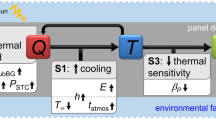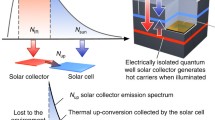Abstract
Solar cell thermal recovery has recently attracted more and more attention as a viable solution to increase photovoltaic efficiency. However, the convenience of the implementation of such a strategy is bound to the precise evaluation of the recoverable thermal power and to a proper definition of the losses occurring within the solar device. In this work, we establish a framework in which all solar cell losses are defined and described. The aim is to determine the components of the thermal fraction. We therefore describe an experimental method to precisely compute these components from the measurement of the external quantum efficiency, the current–voltage characteristics, and the reflectivity of the solar cell. Applying this method to three different types of devices (bulk, thin film, and multi-junction), we could exploit the relationships among losses for the main three generations of PV cells available nowadays. In addition, since the model is explicitly wavelength dependent, we could show how thermal losses in all cells occur over the whole solar spectrum, and not only in the infrared region. This demonstrates that profitable thermal harvesting technologies should enable heat recovery over the whole solar spectral range.




Similar content being viewed by others
References
IEA-PVS. Snapshot of Global Photovoltaic Markets—Report IEA PVPS T1 29:2016 (2015)
A. Polman, M. Knight, E.C. Garnett, B. Ehrler, and W.C. Sinke, Photovoltaic Materials: Present Efficiencies and Future Challenges, Science, 2016, 352, p aad4424
K. Yazawa and A. Shakouri, Cost-Efficiency Trade-off and the Design of Thermoelectric Power Generators, Environ. Sci. Technol., 2011, 45, p 7548–7553
V.V. Tyagi, S.C. Kaushik, and S.K. Tyagi, Advancement in Solar Photovoltaic/Thermal (PV/T) Hybrid Collector Technology, Renew. Sustain. Energy Rev., 2012, 16, p 1383–1398. https://doi.org/10.1016/j.rser.2011.12.013
N. Wang, L. Han, H. He, N.-H. Park, and K. Koumoto, A Novel High-Performance Photovoltaic–Thermoelectric Hybrid Device, Energy Environ. Sci., 2011, 4, p 3676. https://doi.org/10.1039/c1ee01646f
K.-T. Park, S.-M. Shin, A.S. Tazebay, H.-D. Um, J.-Y. Jung, S.-W. Jee et al., Lossless Hybridization Between Photovoltaic and Thermoelectric Devices, Sci. Rep., 2013, 3, p 422–427
T.-J. Hsueh, J.-M. Shieh, and Y.-M. Yeh, Hybrid Cd-Free CIGS Solar Cell/TEG Device with ZnO Nanowires, Prog. Photovoltaics Res. Appl., 2015, 23, p 507–512
B. Lorenzi, M. Acciarri, and D. Narducci, Conditions for Beneficial Coupling of Thermoelectric and Photovoltaic Devices, J. Mater. Res., 2015, 30, p 2663–2669. https://doi.org/10.1557/jmr.2015.174
D. Narducci and B. Lorenzi, Challenges and Perspectives in Tandem Thermoelectric-Photovoltaic Solar Energy Conversion, IEEE Trans. Nanotechnol., 2016, https://doi.org/10.1109/tnano.2016.2524680
T.T. Chow, A Review on Photovoltaic/Thermal Hybrid Solar Technology, Appl. Energy, 2010, 87, p 422–427
A.G. Aberle, W. Zhang, and B. Hoex, Advanced loss Analysis Method for Silicon Wafer Solar Cells, Energy Procedia, 2011, 8, p 244–249. https://doi.org/10.1016/j.egypro.2011.06.131
J. Greulich and S. Rein, Numerical Power Balance and Free Energy Loss Analysis for Solar Cells Including Optical, Thermodynamic, and Electrical Aspects, J. Appl. Phys., 2013, 114, p 204504. https://doi.org/10.1063/1.4832777
J. Wong, S. Duttagupta, R. Stangl, B. Hoex, and A.G. Aberle, A Systematic Loss Analysis Method for Rear-Passivated Silicon Solar Cells, IEEE J. Photovolt., 2015, 5, p 619–626
S. Wasmer, A. Van Der Horst, P. Saint-cast, and J. Greulich, Modeling-Free Efficiency Gain Analysis of Passivated Emitter and Rear Silicon Solar Cells, IEEE J. Photovolt., 2018, 8, p 689–696
O. Dupré, R. Vaillon, and M.A. Green, Physics of the Temperature Coefficients of Solar Cells, Sol. Energy Mater. Sol. Cells, 2015, 140, p 92–100. https://doi.org/10.1016/j.solmat.2015.03.025
O. Dupré, R. Vaillon, and M.A. Green, A Full Thermal Model for Photovoltaic Devices, Sol. Energy, 2016, 140, p 73–82. https://doi.org/10.1016/j.solener.2016.10.033
M.A. Steiner, J.F. Geisz, J. Scott Ward, I. Garcia, D.J. Friedman, R.R. King et al., Optically Enhanced Photon Recycling in Mechanically Stacked Multijunction Solar Cells, IEEE J. Photovolt., 2016, 6, p 358–365. https://doi.org/10.1109/JPHOTOV.2015.2494690
X. Sheng, M.H. Yun, C. Zhang, A.M. Al-Okaily, M. Masouraki, L. Shen et al., Device Architectures for Enhanced Photon Recycling in Thin-Film Multijunction Solar Cells, Adv. Energy Mater., 2015, 5, p 1400919. https://doi.org/10.1002/aenm.201400919
D.M. Tex, M. Imaizumi, H. Akiyama, and Y. Kanemitsu, Internal Luminescence Efficiencies in InGaP/GaAs/Ge Triple-Junction Solar Cells Evaluated from Photoluminescence Through Optical Coupling Between Subcells, Sci. Rep., 2016, 6, p 38297. https://doi.org/10.1038/srep38297
C.J. Hibberd, F. Plyta, C. Monokroussos, M. Bliss, T.R. Betts, and R. Gottschalg, Voltage-Dependent Quantum Efficiency Measurements of Amorphous Silicon Multi-Junction Mini-Modules, Sol. Energy Mater. Sol. Cells, 2011, 95, p 123–126. https://doi.org/10.1016/J.SOLMAT.2010.03.039
R.R. King, C. Fetzer, P. Chiu, E. Rehder, K. Edmondson, and N. Karam, Group-IV Subcells in Multijunction Concentrator Solar Cells, ECS Trans., 2012, 50, p 287–295. https://doi.org/10.1149/05009.0287ecst
M. Acciarri, S. Binetti, A. Le Donne, B. Lorenzi, L. Caccamo, L. Miglio et al., Development of a Hybrid Sputtering/Evaporation Process for Cu(In, Ga)Se2 thin film solar cells, Cryst. Res. Technol., 2011, 46, p 871–876. https://doi.org/10.1002/crat.201000670
S. Marchionna, P. Garattini, A. Le Donne, M. Acciarri, S. Tombolato, and S. Binetti, Cu2ZnSnS4 Solar Cells Grown by Sulphurisation of Sputtered Metal Precursors, Thin Solid Films, 2013, 542, p 114–118. https://doi.org/10.1016/j.tsf.2013.06.084
S. Yaşar, S. Kahraman, S. Çetinkaya, Ş. Apaydın, İ. Bilican, and İ. Uluer, Numerical Thickness Optimization Study of CIGS Based Solar Cells with wxAMPS, Opt. Int. J. Light Electron. Opt., 2016, 127, p 8827–8835. https://doi.org/10.1016/J.IJLEO.2016.06.094
M.J. Taghavi, M. Houshmand, M.H. Zandi, and N.E. Gorji, Modeling of Optical Losses in Perovskite Solar Cells, Superlattices Microstruct., 2016, 97, p 424–428. https://doi.org/10.1016/j.spmi.2016.06.031
L.C. Hirst and N.J. Ekins-Daukes, Fundamental Losses in Solar Cells, Prog. Photovolt. Res. Appl., 2011, 19, p 286–293. https://doi.org/10.1002/pip.1024
W. Shockley and H.J. Queisser, Detailed Balance Limit of Efficiency of p-n Junction Solar Cells, J. Appl. Phys., 1961, 32, p 422–427. https://doi.org/10.1063/1.1736034
Y. Vorobiev, J. González-Hernández, P. Vorobiev, and L. Bulat, Thermal-Photovoltaic Solar Hybrid System for Efficient Solar Energy Conversion, Sol. Energy, 2006, 80, p 170–176
D. Kraemer, L. Hu, A. Muto, X. Chen, G. Chen, and M. Chiesa, Photovoltaic-Thermoelectric Hybrid Systems: A General Optimization Methodology, Appl. Phys. Lett., 2008, https://doi.org/10.1063/1.2947591
M. Mizoshiri, M. Mikami, K. Ozaki, and K. Kobayashi, Thin-Film Thermoelectric Modules for Power Generation Using Focused Solar Light, J. Electron. Mater., 2012, 41, p 1713–1719
G. Friesen, D. Pavanello, A. Virtuani, Overview of Temperature Coefficients of Different Thin Film Photovoltaic Technologies. 25th European Photovoltaic Solar Energy Conference and Exhibition/5th World Conference on Photovoltaic Energy Conversion, 6–10 Sept 2010, Val Spain 2010:422–7. https://doi.org/10.4229/25theupvsec2010-4av.3.83
C.H. Henry, Limiting Efficiencies of Ideal Single and Multiple Energy Gap Terrestrial Solar Cells, J. Appl. Phys., 1980, 51, p 4494. https://doi.org/10.1063/1.328272
P.F. Baldasaro, J.E. Raynolds, G.W. Charache, D.M. DePoy, C.T. Ballinger, T. Donovan et al., Thermodynamic Analysis of Thermophotovoltaic Efficiency and Power Density Tradeoffs, J. Appl. Phys., 2001, 89, p 3319–3327. https://doi.org/10.1063/1.1344580
T. Markvart, Thermodynamics of Losses in Photovoltaic Conversion, Appl. Phys. Lett., 2007, 91, p 064102. https://doi.org/10.1063/1.2766857
P.T. Landsberg and V. Badescu, Carnot factor in Solar Cell Efficiencies, J. Phys. D Appl. Phys., 2000, 33, p 3004–3008. https://doi.org/10.1088/0022-3727/33/22/320
D.T. Cotfas, P.A. Cotfas, D. Ursutiu, C. Samoila, The Methods to Determine the Series Resistance and the Ideality Factor of Diode for Solar Cells-Review. 2012 13th International Conference on Optimization of Electrical and Electronic Equipment, IEEE; 2012, p. 966–72. https://doi.org/10.1109/optim.2012.6231814
Acknowledgments
This project has received funding from the European Union’s Horizon 2020 research and innovation programme under the Marie Skłodowska-Curie Grant No. 745304.
Author information
Authors and Affiliations
Corresponding author
Additional information
This article is an invited paper selected from presentations at “GiTE 2018” (Thermoelectricity Days), held February 21-22, 2018, in Santa Margherita Ligure, Italy, and has been expanded from the original presentation.
Appendix A: Computation of \(\varvec{L}_{4}\) Components
Appendix A: Computation of \(\varvec{L}_{4}\) Components
In this section, we show how to split the \(L_{4}\) components. As mentioned in section 2, \(L_{4}\) losses are voltage drops associated with \(L_{3}\) losses. Actually, current losses \(L_{3}\) impact the generation–recombination balance, reducing the voltage that the device can generate and are the reason why solar cells exhibit voltages smaller than \(E_{\text{g}} /q\). The sum of these voltage losses actually accounts for the difference between \(E_{\text{g}} /q\) and voltage at maximum power \(V_{\text{mp}}\).
Previous studies (Ref 15, 26, 32,33,34) showed how the sum of two of such losses corresponds to the radiative recombination \(L_{{3{\text{rad}}}}\). The first is called Carnot loss (\(L_{{4{\text{carnot}}}}\)) with a corresponding voltage drop firstly derived by Landsberg and Badescu (Ref 35):
with \(T_{\text{c}}\) the cell temperature and \(T_{\text{s}}\) the temperature of the Sun. This loss takes into account only radiative emission in the solid angle within which the device absorbs the solar spectrum. The second is instead the so-called Boltzmann voltage loss (\(L_{{4{\text{boltz}}}}\)) which takes into account the difference between the solid angle within which the solar cell absorbs the solar power, and the solid angle within which it emits. The voltage drop associated can be calculated as
where \(k_{\text{B}}\) is the Boltzmann constant and \(\varOmega_{\text{emit}}\) and \(\varOmega_{\text{abs}}\), respectively, the emission and absorption solid angles.
We then define with \(L_{{4{\text{Nrad}} - {\text{V}}}}\), and \(L_{{4{\text{s}}}}\) the voltage drops corresponding to non-radiative recombination and to electrical shunts.
The total voltage drop due to \(L_{4}\) (hereafter \(\Delta V_{4}\)) is therefore equal to
While \(V_{\text{mp}}\) is known from the solar cell current–voltage characteristic, and the Carnot and Boltzmann contributions are known from Eq 25 and 26, one can obtain the sum of the two unknown voltage drops as
Finally, knowing from Eq 18, the total \(L_{4}\), and from Eq 25, 26, and 28, the ratio between the different components, one can sort out the loss components \(L_{{4{\text{carnot}}}}\), \(L_{{4{\text{boltz}}}}\), and (\(L_{{4{\text{Nrad}} - {\text{V}}}} + L_{{4{\text{s}}}}\)).
It is worth to point out that \({{\Delta }}V_{{4{\text{s}}}}\) can also be extracted by the determination of the solar cell series resistance as
where \(R_{\text{s}}\) is the series resistance which can be obtained from the solar cell IV characteristic by several methods (Ref 36) and \(I_{\text{mp}}\) is the solar cell current at maximum power.
Note that the method does not allow to obtain the spectral dependency of the \(L_{4}\) components.
Rights and permissions
About this article
Cite this article
Lorenzi, B., Acciarri, M. & Narducci, D. Experimental Determination of Power Losses and Heat Generation in Solar Cells for Photovoltaic-Thermal Applications. J. of Materi Eng and Perform 27, 6291–6298 (2018). https://doi.org/10.1007/s11665-018-3604-3
Received:
Revised:
Published:
Issue Date:
DOI: https://doi.org/10.1007/s11665-018-3604-3




